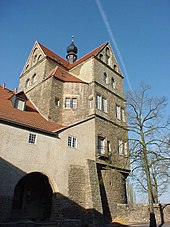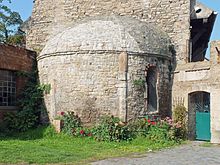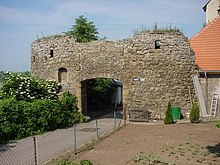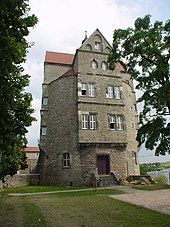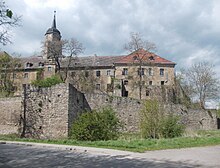Seeburg Castle (Hassegau)
Seeburg Castle is a Renaissance - castle in Seeburg in Mansfeld-Südharz , Saxony-Anhalt . The complex goes back to a castle that belonged to the so-called castles of the Hersfeld catalog of tithe and was the seat of the count family of the same name.
history
Research history
For a long time, Seeburg Castle on the Süßen See was equated with a Hoohseoburg (Hocseburg, Ocsioburg, etc.) mentioned several times in the written sources in the 740s . Karlmann , the son of Karl Martell , undertook a campaign in 743 to what is now East Westphalia . He also conquered the Hoohseoburg, an important castle complex of the Saxon great Theodoric, and took this prisoner. Theodoric had to commit himself to submission and tribute to the Franconian Empire. But just a year later, in 744, there was an uprising. Theodoric was defeated and taken as a prisoner to the Frankish Empire . The castle was probably destroyed after the conquest.
With this, the reaching back of all the other castles in the Hersfeld Tithing Directory to the 8th century seemed certain. This found an apparently independent support with the assumption of the medieval historian Walter Schlesinger that this tithe was to be identified with the tithe of the Free in the Hochseegau donated to the Hersfeld Monastery in 780. Schlesinger himself refrained from some of the theories he had expressed in 1941 at the latest in 1964. B. from the naming of the Hassegau as Hochseegau. The lack of any archaeological finds from the 8th century and the noticeable distance to the other places in the context of the Frankish disputes with the Saxons , however, have long led to discussions as to whether this equation is justified and to further localization suggestions.
In connection with the archaeological excavations of the Hünenburg on the Heeseberg near Watenstedt , also proposed for the localization of the Hoohseoburg as early as 1927, finds and findings from the 8th century were established. It is far more likely that the Hoohseoburg can be identified with this castle, which is located in the heartland of Saxony, and not with the Seeburg on the Süßen See.
First mention
The oldest reliable information about the history of the castle can be found in the Hersfeld tithe directory . The Seeburg was mentioned here at the end of the 9th century. In 1036 a count of Seeburg was mentioned. It was about Christin, Count von Seeburg (around 1016 - before 1067). He was the son of Gebhard I von Querfurt , an important dynast in the region. Christin is the first of the family to hold the title of count. This is possibly due to his marriage to the Bavarian Countess von Gleiß . Christin will have started building the stone castle at the west end of the old people's castle. The huge keep with a wall thickness of almost six meters was built under his son Wichmann I. von Seeburg around 1080 (H. Wäscher). Other stone buildings such as the Palas, a chapel and a first curtain wall can certainly be attributed to his work.
Wichmann I's grandson, Wichmann II von Seeburg (around 1116–1192), was the most important personality in the family. He was elected Archbishop of Magdeburg in 1152 . He played a key role in the battles of Albrecht the Bear against the Slavs in Brandenburg and in the battles against Henry the Lion . After the Archbishop of Cologne , he was considered the most influential prince in the empire.
Seeburg Castle was significantly expanded under his rule. The 1st Zwingermauer with flanking towers and the "Blue House", the archbishop's palace, and the gate house were built. In 1172 Wichmann founded a collegiate monastery on the western tip of the peninsula. A new church and the corresponding residential buildings were built here. A new entrance with a separate lower forecourt was created at the southeast corner of the complex.
In the years 1182 to 1184 Wichmann donated the castle to the ore monastery of Magdeburg. His brother Konrad I died in 1182 and his son Konrad II von Seeburg was destined for the clergy. Konrad II became provost of the canon monastery in Seeburg.
In 1287 Burchard IV bought the Seeburg rule from the up-and-coming family of the Counts of Mansfeld . Under the counts in the 15th century, the castle became the most important late Gothic building in the county. In the second half of the 15th century, the second castle wall with flanking towers and a gate castle was built . The lower part of the widow's tower was built as a strong battery tower during this time.
16th to 19th century
In 1501 the castle came to Count Gebhard VII von Mansfeld-Mittelort in one of the many inheritance divisions. Like the entire Mansfeld Count's House, he was seized by a veritable building frenzy and had the castle redesigned into a representative residential palace. Between 1515 and 1518 the hall in the main castle was extended to create a 9.5 × 30 m² ballroom. The widow's tower received the multi-storey residential structure. Not least because of the rampant building activity, the counts got into financial difficulties. In 1570 the county was sequestrated . In 1575 they had to sell the Seeburg rule to Kuno Hahn from the Mecklenburg family of nobility Hahn . At the end of the 16th century, the keep was partially removed and added to the structure that exists today. In 1665 the “New House” was built on the north and west side of the core castle in the baroque style.
In 1780 the Seeburg branch of the Hahn family went out and the heirs of Geusau later sold the property to the Count of Ingenheim . In the 19th century a new road was laid through the lower courtyard. The blue building was torn down for this purpose. The buildings of the outer bailey were put down and the ditch between the outer and inner bailey was filled.
In 1880 the Ingenheims sold the already clearly dilapidated castle to the Wendenburg family. After 1910 work began on restoring the castle in the style of the time. Erich Wendenburg had extensive construction work carried out in 1923 according to the drafts of the architect Paul Schultze-Naumburg .
20th century
In October 1933 a National Socialist Gauführerschule for the Gau Halle-Merseburg was set up in the castle . The owners, the Wendenburg family, were expropriated by the Soviet occupying forces as part of the land reform in 1945 and had to flee to avoid being captured. Part of the castle was used as a vocational school and a youth hostel was set up in the widow's tower.
After the fall of the Wall, the Federal Republic of Germany did not return the family's property - like all others that were expropriated between 1945 and 1949 - but instead sold it to non-local investors. The previous owner was banned from building, but according to the Compensation and Compensation Act of 1994, he was entitled to all expropriated movables.
The castle has been in shared private ownership since the late 1990s and is used for various purposes. The Upper Castle belongs to a consulting company from Weinheim , has not been renovated and is empty. The widow's tower and the castle church, however, have been renovated and are owned by ObstGut LANGELS GbR . They are used as a residence, for holiday apartments, as a registry office as well as for concerts and events. With the new construction of the orangery on the lake promenade, in cooperation with the local action group (LAG) "Mansfelder Land", the municipality Seegebiet Mansfelder Land and the operators of the castle café, another big step has now been taken towards tourist use, with the architecturally demanding new building year-round operation possible. Until the end of 2019 there was the Schloss Seeburg winery, with its vineyards in Höhnstedt ( Höhnstedter Kelterberg ) and Seeburg ( Seeburger Himmelshöhe ). The Seeburg thus belonged to the Mansfeld Lakes Wine Route and the Saale-Unstrut region , and the existing apse to the Romanesque Route . The new owners of the castle have given notice to the winery and thus smashed it.
Seeburg Castle is located directly at the interface between the Romanesque Road, the Luther Trail Saxony-Anhalt, the Sky Disc Trail and the Mansfeld Lakes Wine Road.
literature
- Georg Christian Friedrich Lisch : History and documents of the Hahn family. Volume 4: Containing the Basedow-Seeburg line. Schwerin 1856 ( digitized version), pp. 2–22
- K. Heine: Seeburg Castle and its residents. A contribution to the local history of the county of Mansfeld. In: Zeitschrift des Harz-Verein für Geschichte und Alterthumskunde 30 (1897), pp. 299–330 ( digitized version , UB Jena)
- Georg Dehio : Handbook of art monuments, The district of Halle . Akademie-Verlag, Berlin 1976.
- Paul Grimm : The prehistoric and early historical castle walls of the districts of Halle and Magdeburg . Akademie-Verlag, Berlin 1958.
- Hermann Großler : Gender studies of the counts of Seeburg and the noblemen of Lutisburg . Mansfeld leaves. Announcements from the Association for History and Antiquities of the County of Mansfeld zu Eisleben, Eisleben 1889, 3rd year.
- Irene Roch-Lemmer: The "Mansfeld Chronica" by Cyriakus Spangenberg as a historical source for castles and palaces in the Mansfeld region . In: Castles and palaces in Saxony-Anhalt . Issue 13, hall 2004.
- Hermann Wäscher : Feudal castles in the districts of Halle and Magdeburg . Henschelverlag Art and Society, Berlin 1962.
- Berent Schwineköper (Hrsg.): Handbook of the historical sites of Germany . Volume 11: Province of Saxony Anhalt (= Kröner's pocket edition . Volume 314). 2nd, revised and expanded edition. Kröner, Stuttgart 1987, ISBN 3-520-31402-9 .
Web links
- Orangery Seeburg
- Seeburg Castle
- Seeburg Castle Winery
- Material on Seeburg Castle (PDF; 226 kB) in the Alexander Duncker collection
Individual evidence
- ↑ Anke Losack: The winery is over: winemaker Rainer Strohm has to move out of Seeburg Castle. July 24, 2018, accessed on July 19, 2020 (German).
Coordinates: 51 ° 29 ′ 27.8 " N , 11 ° 41 ′ 58.6" E



